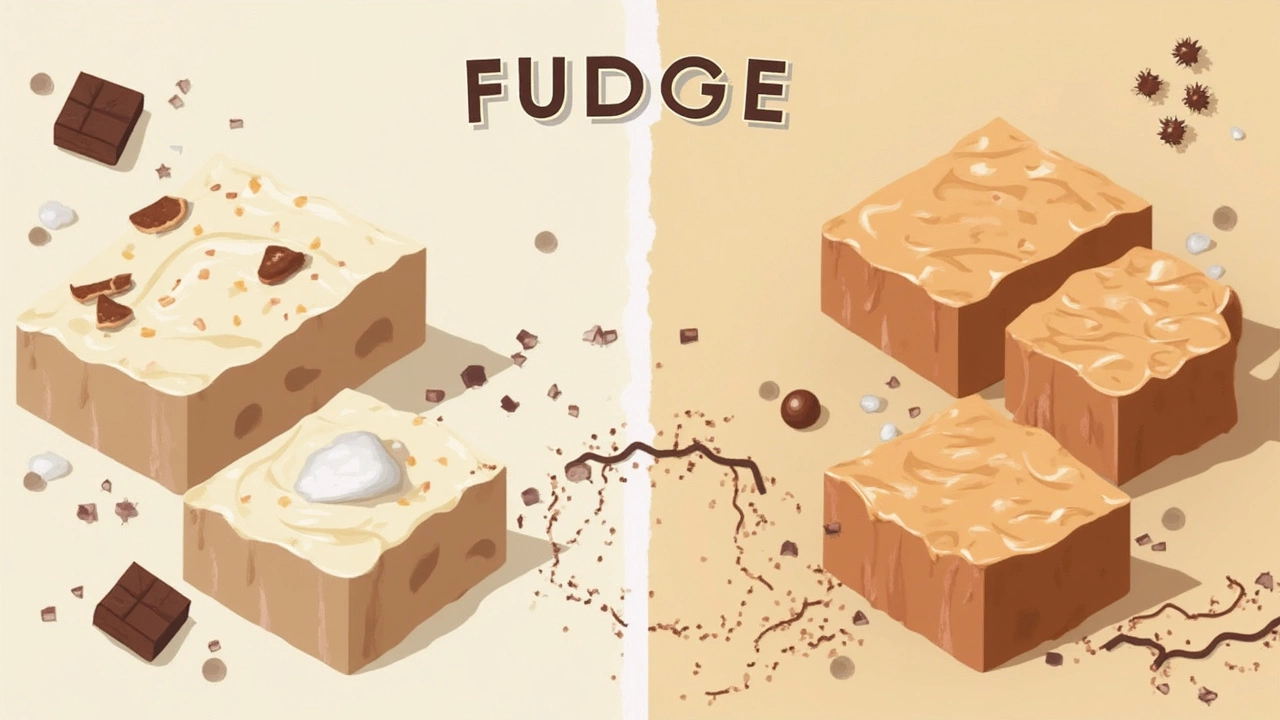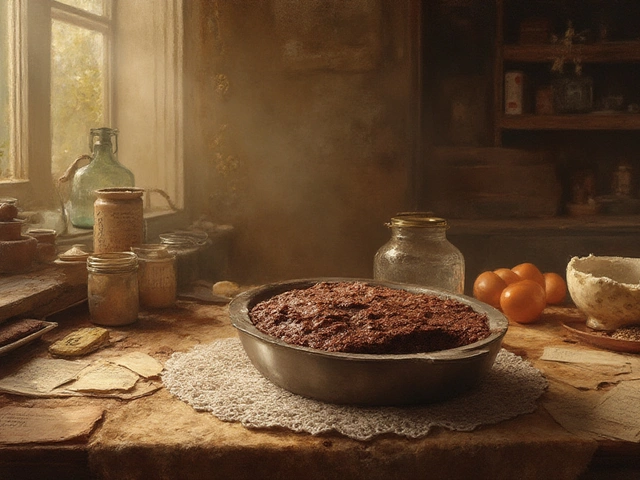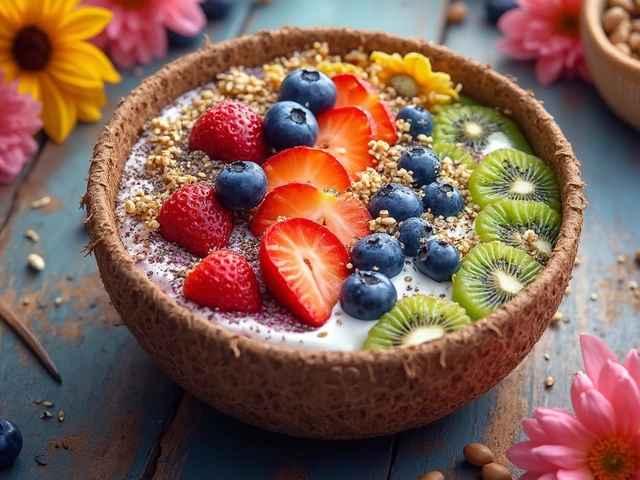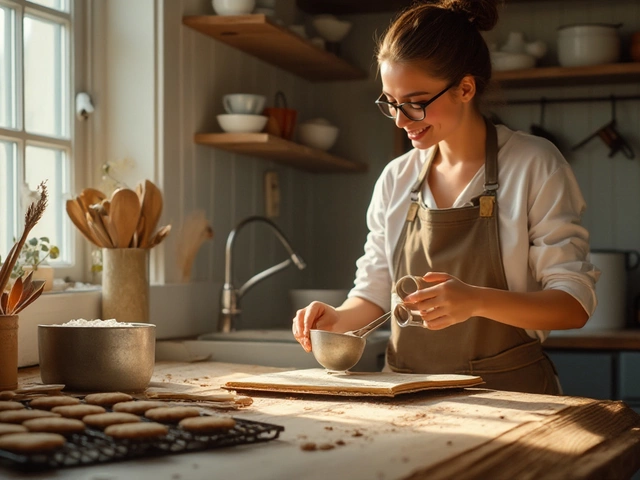
Fudge is the answer for anyone who thinks chocolate bars just aren’t decadent enough. There’s something wild about biting into a piece of fudge: it snaps yet melts, feeling impossibly rich but never actually heavy. But the real kicker is that unmistakable fudge taste—more than just sugar and chocolate, it has a warm, caramel edge with whispers of vanilla, swirled into a velvety bite. What’s really happening on your tongue, and why does fudge taste like fudge and not just like softened chocolate? It’s a mix of magical science (no, really), careful timing, and tiny, undetectable crystals. Most people don’t know that fudge is as tricky as soufflé without a safety net. There’s no cheating the process—and science says so.
The Unique Chemistry That Sets Fudge Apart
Anyone can grab a bar of chocolate, but making real fudge is an act of controlled chaos. Let’s dig into what gives fudge its unique personality. The secret ingredient isn’t even in your pantry: it’s the process. Fudge is basically a cooked sugar syrup—typically sugar, butter, milk (or cream), and usually chocolate—that’s heated to a very specific temperature. If you’ve ever been hounded by recipes that say “use a candy thermometer,” fudge is why. You heat your mixture to just around 112–115°C (234–240°F), right where the sugar dissolves, but the water hasn’t all boiled away. Why? The temperature sets up the texture—too low, and it’s gooey; too high, and you’ve made toffee instead.
But here’s where fudge leaps into the weird world of chemistry. As your hot syrup cools, it’s filled with a supersaturated solution—imagine thousands of sugar molecules just itching to crystallize. But we don’t want those big, grainy, gritty crystals. We want the tiniest, smoothest ones possible. That’s what creates fudge’s velvety mouthfeel. The traditional method is to cool the pot, untouched, until it’s about 46°C (115°F), and then you beat it until your arm aches. This is when you’re seeding millions of microcrystals, giving fudge its famously creamy texture. Go too soon, and you’ll have a gritty mess. Too late, and you’ll be stuck with a sticky goo.
What’s wild is that even a single stray grain of sugar can cause the whole batch to crystallize too soon, turning your dream fudge into a brick. That’s why recipes tell you to wash down the sides of the pan with a wet brush, to keep everything smooth. And the real fudge fans in Brighton know this: humidity matters more than you think. Sticky, damp air can ruin a day’s work, pulling moisture from your fudge and making it clammy or even weepy—yes, weepy fudge is a thing, and nobody wants that in a picnic box.
Flavor: More Than Just Chocolate and Sugar
So fudge is science in a pan—but why does it taste so special? You’d think “lots of chocolate” does all the heavy lifting. But classic fudge flavor is a balance of several elements, and chocolate sometimes takes a backseat to everything else going on. It all starts with caramelization: when you heat your sugar (and especially when you add milk or cream), you enter the Maillard Reaction zone—the same chemical magic that gives toasted marshmallows and seared steak those intense, deep notes. That’s why good fudge tastes richer and a little more complex than straight chocolate.
Most fudge includes a generous splash of vanilla, and that’s not just for tradition—it cuts through the sweetness, giving it lift, and rounds off any sharp notes from cocoa or caramel. If you skip vanilla, fudge can taste flat and heavy. Butter, meanwhile, isn’t just fat, it’s flavor: it brings everything together and helps carry both the chocolate and the caramel notes to your taste buds. Some bakers sneak in a pinch of salt—not enough to taste salty, but just enough to enhance the sweetness and balance any bitterness from dark chocolate.
Then there are the upgrades. Some people swear by swapping cream for sweetened condensed milk. Others fold in tangy sour cream or marshmallow creme for an extra pillowy bite—a trick popularized in American “fantasy fudge” recipes from the 1960s. In Wales, a little drizzle of golden syrup or a spoonful of honey is the secret to that bolder butterscotch undertone. Brighton’s seaside fudge stands often use locally churned butter, which is extra rich and a bit tangy, altering the flavor in charmingly unpredictable ways.
Let’s not forget inclusions. Roasted nuts, cranberries, candied orange, or a flick of sea salt—each changes the profile, but the smallest batch of plain fudge still stands out as itself. It’s that interplay of caramel, dairy, chocolate, and vanilla—plus the fine, crystalline texture—that makes fudge, well, fudge.

The Make-or-Break Texture: Getting It Creamy (Not Crumbly)
Ask anyone who’s ruined fudge: the taste alone isn’t enough. Texture is where the bragging rights come in. Fudge shouldn’t be gritty, dense, or crumbly—it needs to break cleanly but melt instantly on your tongue. Texture is almost a personality trait. Pull it off right and you’ll have friends at every holiday, for life. But fudge is notorious for “turning” at the last second, leaving experienced cooks sobbing into their pans.
Here’s how to nail it: pay more attention to process than to ingredients list. That means watching not just your thermometer (can’t fake this!), but also your stirring habits. Too much stirring while it cooks encourages sugar to crystallize early—which, as we’ve learned, means grainy fudge. But too little stirring during the cooling-beating phase, and those tiny crystals never form properly, leaving you with a sticky, taffy-like lump. Experienced fudge makers wait for the perfect temperature, then beat with relentless enthusiasm. If you try to cheat and use a stand mixer, don’t overdo it or you’ll smash those delicate crystals and make a sad, dull block.
A couple of home truths: Fudge texture is easier to control in small pans. The British National Trust did some fun research in old kitchens and found that cooks who made double or triple batches were much more likely to end up with weird, inconsistent textures. It turns out, the wider surface area of the pan affects how quickly the mixture cools, which changes how the sugar sets up. And forget what you’ve heard about “setting in the fridge.” Real fudge loves room temperature. Chill it too soon and it crackles.
Want a useful trick? If you’ve ever seen “cream of tartar” or “glucose syrup” on a fudge recipe, it’s a texture fix—these additives slow the formation of big crystals, giving you a better, more luxurious bite. No need for chemistry lab panic: a squeeze of golden syrup or a drop of lemon juice does the trick for the home cook. Another Brighton kitchen hack: line your pan with parchment and let the fudge cool undisturbed. Trying to rush it or scoop it out early will wreck all your best efforts. Remember—texture is king, and patience pays off.
Tips, Tricks, and Fudge Fiascos To Avoid
Ever tried to make fudge and ended up with a gooey puddle or an inflexible chocolate brick? You’re in good company. Here’s how to skip the disasters and get creamy fudge every batch. First, it really is worth getting a good thermometer—digital ones are cheap and way less guesswork than watching a sugar drop sink in cold water. Keep everything scrupulously clean, because a single grain of sugar will wreck things before you even begin. Don’t double batches until you’ve nailed the basics. If you’re using chocolate, use real chocolate (and splurge for a good bar rather than compound or chips)—the fat-to-cocoa ratio matters for smoothness.
When you add extras, like nuts or fruit, fold them in only at the end, when the fudge is already thickening up—if they go in too soon, the sugar structure can fall apart. For vegan fudge fans, coconut milk and plant butters work shockingly well, though you’ll need to pay closer attention since plant-based milks burn more easily. For anyone who ends up with grainy fudge, you can sometimes rescue it by gently re-melting with a splash of milk and beating again once it cools (a trick I swore off after the second midnight kitchen meltdown, but still, it does work).
Locals say sea air changes fudge—don’t leave it uncovered near an open window on a stormy Brighton day. Humidity is the enemy, and fudge will pick up water, turning sticky before your guests arrive. Always store completed fudge in an airtight tin with parchment between layers, and tuck a slice of toasted bread in the container so it absorbs stray moisture, keeping every bite perfect. Never wrap warm fudge; it needs to cool completely before storage or you’ll find condensation turns your treat into a soggy sorrow.
Brighton’s best fudge shops hold tightly guarded recipes, but the chemistry is always the same: careful heating, patient cooling, and enthusiastic beating. All that fuss is what makes fudge fudge—not just a sweet, but the thrill of nailing the fine line between chaos and creamy perfection every single batch. Once you taste that real, buttery, melt-on-your-tongue bite, you’ll know: fudge isn’t just chocolate. It’s science you can eat—and who doesn’t want that?





